Just like our last Imprint Thailand tour, the day one highlight for Chiang Mai was a late afternoon visit to Wat Doi Suthep. It is easy to get “templed out” and begin to glaze over in Thailand but WDS is a singularly wonderful experience - and this tour was especially so. Upon arrival we opted for the handy funicular which swept us up to the hilltop complex where we were greeted with a tremendous view over Chiang Mai valley. Photo ops demanded our attention at every step as the group greedily snapped shots of saffron-robed monks, giant ceremonial drums, rows of bells, sacred trees, shrines, alters, inlaid teak doors, and the gilded, multichromatic splendor of the Lanna-style architecture. But the genuine “behind the curtain” cultural connections were provided by our guide Ae. 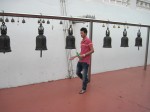 First we learned about the significance of the bells. The ringing of bells purify the temple and, according to general Asian belief, protect from evil spirits. Additionally, according to some forms of Buddhism, bells represent an offering to all buddhas and their ringing accumulates merit (the Buddhist term for gaining positive karma). Lastly, bells represent wisdom so ringing extends the purifying effect to the banishing of confusion. Next we observed the elephant monument which
First we learned about the significance of the bells. The ringing of bells purify the temple and, according to general Asian belief, protect from evil spirits. Additionally, according to some forms of Buddhism, bells represent an offering to all buddhas and their ringing accumulates merit (the Buddhist term for gaining positive karma). Lastly, bells represent wisdom so ringing extends the purifying effect to the banishing of confusion. Next we observed the elephant monument which 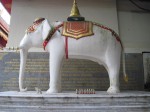 marks the spot of the wat’s foundation legend. Centuries ago a Lanna king came into possession of an important relic. Not being sure of an auspicious place to consecrate a proper temple, he had the relic transported by a sacred white elephant. The holy animal eventually climbed to the top of the present mountain, circled three times and died. The king built his temple and the monument marks the spot of the elephant’s final resting place. Then we learned why there is a Bodhi tree in the compound. The Bodhi is the tree under which the Buddha meditated while seeking enlightenment. Like relics such as splinters of the True Cross in Catholicism, certain wats are blessed with having scions of the original Bodhi. According to local tradition, such is the tree here at WDS. The connection experiences ratcheted up a notch upon ascending to the topmost temple courtyard, splendidly dominated by the glistening gold stupa.
marks the spot of the wat’s foundation legend. Centuries ago a Lanna king came into possession of an important relic. Not being sure of an auspicious place to consecrate a proper temple, he had the relic transported by a sacred white elephant. The holy animal eventually climbed to the top of the present mountain, circled three times and died. The king built his temple and the monument marks the spot of the elephant’s final resting place. Then we learned why there is a Bodhi tree in the compound. The Bodhi is the tree under which the Buddha meditated while seeking enlightenment. Like relics such as splinters of the True Cross in Catholicism, certain wats are blessed with having scions of the original Bodhi. According to local tradition, such is the tree here at WDS. The connection experiences ratcheted up a notch upon ascending to the topmost temple courtyard, splendidly dominated by the glistening gold stupa.  The glowing monument is surrounded by Buddha statues, alter niches, chapels, shrines, chedis, and various other temple elements. A steady but slight breeze cooled us and provided background music from hundreds of tiny temple bells. As westerners we were struck by the temple’s natural beauty but understood little else until Ae began to unwind its secrets for us. First she borrowed the Hundred “Years Old Calendar” book which contains the days of the week for specific dates going back a century - important because every Thai Buddhist needs to know his day of birth to know his or her sacred color, patron animal, and corresponding Buddha position.
The glowing monument is surrounded by Buddha statues, alter niches, chapels, shrines, chedis, and various other temple elements. A steady but slight breeze cooled us and provided background music from hundreds of tiny temple bells. As westerners we were struck by the temple’s natural beauty but understood little else until Ae began to unwind its secrets for us. First she borrowed the Hundred “Years Old Calendar” book which contains the days of the week for specific dates going back a century - important because every Thai Buddhist needs to know his day of birth to know his or her sacred color, patron animal, and corresponding Buddha position. Everyone in the group learned their sacred connections. For example, my color is blue, my animal avatar is the rooster, and the Buddha position is standing with arms crossed - symbolic of contemplation.
Everyone in the group learned their sacred connections. For example, my color is blue, my animal avatar is the rooster, and the Buddha position is standing with arms crossed - symbolic of contemplation.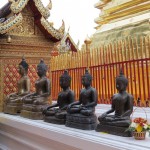 Next, those inclined received a blessing from a monk. We kneeled before him while he chanted and used a bundle of thin sticks to shake water on us. Water is a metaphor for the divine presence and a symbol of ritual purification. It felt like being baptized. Then he tied a white strand of yarn around the men’s wrists and laid a strand out for women to pick up and tie on (it is forbidden for a monk to touch a woman or vice versa.) The thread, known as sai sin, is a symbolic medium for transferring merit. The string aids in retaining good power and protecting from dark influences and is quite powerful when bestowed by a monk. Moving on around the courtyard, we learned about adding oil to an eternally burning lamp. Much like lighting a candle in the Catholic tradition, this ritual signifies devotion to the divine spark in the universe and in believers.
Next, those inclined received a blessing from a monk. We kneeled before him while he chanted and used a bundle of thin sticks to shake water on us. Water is a metaphor for the divine presence and a symbol of ritual purification. It felt like being baptized. Then he tied a white strand of yarn around the men’s wrists and laid a strand out for women to pick up and tie on (it is forbidden for a monk to touch a woman or vice versa.) The thread, known as sai sin, is a symbolic medium for transferring merit. The string aids in retaining good power and protecting from dark influences and is quite powerful when bestowed by a monk. Moving on around the courtyard, we learned about adding oil to an eternally burning lamp. Much like lighting a candle in the Catholic tradition, this ritual signifies devotion to the divine spark in the universe and in believers. 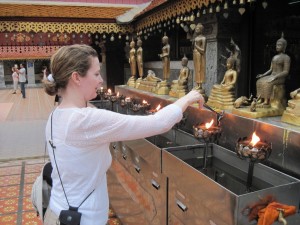 Next door was a joss stick chapel. Supplicants were shaking cups of bamboo sticks until a single stick fell out. A number on the stick corresponded to the person’s fortune, written on small pieces of paper. All of those connection experiences were engaging and helped make Buddhism more understandable and accessible to us. But the ultimate experience, far and away, was the monk chanting ceremony we observed at the end of our visit. Seven monks lined up in front of a shrine in an attitude of prayerful mediation.
Next door was a joss stick chapel. Supplicants were shaking cups of bamboo sticks until a single stick fell out. A number on the stick corresponded to the person’s fortune, written on small pieces of paper. All of those connection experiences were engaging and helped make Buddhism more understandable and accessible to us. But the ultimate experience, far and away, was the monk chanting ceremony we observed at the end of our visit. Seven monks lined up in front of a shrine in an attitude of prayerful mediation. An acolyte lit two huge candles flanking the shrine. A loud, sharp bell rang out from a back corner followed by a deep, resonant, echoing gong. Led by the senior monk, the group chanted a few short lines, followed by the bell and gong again - clearly a call to worship. They filed into the chapel and kneeled before the seated Buddha statue and recommenced with the rhythmic, slightly musical chanting. As if to confirm a divine presence, thunder rolled in the distance. With Ae’s guidance we felt comfortable crowding around the chapel door to observe and listen.
An acolyte lit two huge candles flanking the shrine. A loud, sharp bell rang out from a back corner followed by a deep, resonant, echoing gong. Led by the senior monk, the group chanted a few short lines, followed by the bell and gong again - clearly a call to worship. They filed into the chapel and kneeled before the seated Buddha statue and recommenced with the rhythmic, slightly musical chanting. As if to confirm a divine presence, thunder rolled in the distance. With Ae’s guidance we felt comfortable crowding around the chapel door to observe and listen. 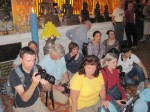 I for one experienced a feeling of ascendance - a sense of connection to the divine within. I felt I was a better person for having experienced the ceremony. Judging by the hushed but passionate enthusiasm of the tour members, I was not alone. As if to cap our WDS experience, just before our
I for one experienced a feeling of ascendance - a sense of connection to the divine within. I felt I was a better person for having experienced the ceremony. Judging by the hushed but passionate enthusiasm of the tour members, I was not alone. As if to cap our WDS experience, just before our  departure we were treated to the arrival of a group of 20 or so young children, all in saffron robes. They are children given into the care of the monastery by families too poor to provide for them properly. They sat quietly in a pavilion in rapt and silent attention; though not from Buddhist discipline but transfixed by a higher power: cartoons on a television! We descended the stunning Naga staircase feeling content and blessed. No sooner had we boarded our bus than the heavens opened and a tropical rainstorm began. The visit confirmed my commitment to seek creative ways to make cultural connections on our tours. Finally, to conclude my musings about Thai Buddhism, I would add that this credo is much more relaxed than it’s western counterparts. Yes there are rules, rituals, obligations, and liturgy to follow. But there seems to be an abiding mai pen rai (no worries) element as well. I felt comfortable participating, engaging, and observing in a way that would seem intrusive in western religions. I like it. I like it a lot. We could use a bit more spiritual “mai pen rai” at home.
departure we were treated to the arrival of a group of 20 or so young children, all in saffron robes. They are children given into the care of the monastery by families too poor to provide for them properly. They sat quietly in a pavilion in rapt and silent attention; though not from Buddhist discipline but transfixed by a higher power: cartoons on a television! We descended the stunning Naga staircase feeling content and blessed. No sooner had we boarded our bus than the heavens opened and a tropical rainstorm began. The visit confirmed my commitment to seek creative ways to make cultural connections on our tours. Finally, to conclude my musings about Thai Buddhism, I would add that this credo is much more relaxed than it’s western counterparts. Yes there are rules, rituals, obligations, and liturgy to follow. But there seems to be an abiding mai pen rai (no worries) element as well. I felt comfortable participating, engaging, and observing in a way that would seem intrusive in western religions. I like it. I like it a lot. We could use a bit more spiritual “mai pen rai” at home.
